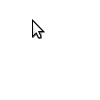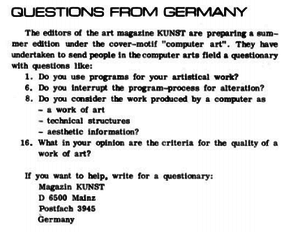User:Joak/mediaobject: Difference between revisions
No edit summary |
No edit summary |
||
| Line 20: | Line 20: | ||
margin-right: auto"> | margin-right: auto"> | ||
the mouse and the interrupt</h1> | the mouse and the interrupt</h1> | ||
<br> | <br> | ||
<p style=" | <p style=" | ||
| Line 32: | Line 31: | ||
In 1970 the editor of German magazine "Kunst" announced in PAGE #9 (the bulletin of the computer arts society)<ref name="page">PAGE #9 July 1970, p. 3, Available from http://www.bbk.ac.uk/hosted/cache/archive/PAGE/PAGE9.pdf</ref>, that they will publish there next edition under the cover-motif "computer art". In a questionary for computer artist the sixth question asked: "Do you interrupt the program-process for alteration?". This is hard to understand if we compare their old computers with this slick almost invisible machines on our desks nowadays! To retrace this question it's necessary to keep in mind the technological circumstances. At this time most of the artist were executing programs from the beginning to the end, to draw in later step they result on a penplotter. So we can assume, once the machine was running a program the only possibility to stop it was to switch off the power. </p> | In 1970 the editor of German magazine "Kunst" announced in PAGE #9 (the bulletin of the computer arts society)<ref name="page">PAGE #9 July 1970, p. 3, Available from http://www.bbk.ac.uk/hosted/cache/archive/PAGE/PAGE9.pdf</ref>, that they will publish there next edition under the cover-motif "computer art". In a questionary for computer artist the sixth question asked: "Do you interrupt the program-process for alteration?". This is hard to understand if we compare their old computers with this slick almost invisible machines on our desks nowadays! To retrace this question it's necessary to keep in mind the technological circumstances. At this time most of the artist were executing programs from the beginning to the end, to draw in later step they result on a penplotter. So we can assume, once the machine was running a program the only possibility to stop it was to switch off the power. </p> | ||
<br> | <br> | ||
[[File:Questionary.png|thumbnail|center]] | |||
<h3 style=" | <h3 style=" | ||
color:black; | color:black; | ||
Revision as of 02:04, 15 October 2014
The following text implies some mistakes evoked by my dyslexia and writing skills! A correction follows soon.
the mouse and the interrupt
In 1970 the editor of German magazine "Kunst" announced in PAGE #9 (the bulletin of the computer arts society)[1], that they will publish there next edition under the cover-motif "computer art". In a questionary for computer artist the sixth question asked: "Do you interrupt the program-process for alteration?". This is hard to understand if we compare their old computers with this slick almost invisible machines on our desks nowadays! To retrace this question it's necessary to keep in mind the technological circumstances. At this time most of the artist were executing programs from the beginning to the end, to draw in later step they result on a penplotter. So we can assume, once the machine was running a program the only possibility to stop it was to switch off the power.
interrupt
But to execute alteration in a running program is in processor-architecture a function implemented called interrupt. Gets the processor triggered by an interrupt request(IRQ), it pauses the program and jumps into an so called interrupt service routine(ISR) or interrupt handler. After executing the code of ISR the processor jumps back into the suspended programm. This event can be caused by software interrupts or hardware interrupts. An example for an software interrupt would be exception handling in the abort of software. The most used example for an hardware interrupt is I/O or Input/Output. Under this you can understand all types devices that are attached to the computer and triggering trough the bus an interrupt pin of the processor. In short, this described procedure enables changes in the ongoing system. The use or actually the planning of interrupts in modern computer architectures started in the 1950. Notable computers are the UNIVAC I(first execption handling), NBS DYSEAC(first I/O interrupts), IBM Stretch and the Dutch Electrologica X1(had seven predifened subroutines). It is not clear which machine had at first interrupts implemented, but the most cited in this case is the UNIVAC 1103/1103A[2].
mouse
An example for an I/O-Device that triggers an interrupt on the processor is the mouse. It is commonly known as an interface for computers. It is moved by the users hand, thereby the object 'mouse' got its shape by the negativ form of the users hand. In generic designs there are two buttons attached under the forefinger and the middle finger of the user. The hands motion is translates by the device into electronic signals and normally represented on the monitor by a small pointer. The invention mouse is connected to the name Douglas Engelbart who applied in 1967 for a patent called "X-y position indicator for a display system"[3]. Before Engelbart a similar system called "trackball" was used for military purpose, but on a wide scale the mouse was introduced in 1972 with the "Xero Alto" one of the first personal computers and the first computer that used the concept of the desktop metaphor[4].
a mouse interrupts an alto
- -> example interrupt xero alto
- -> explaine mouse and the interrupt
final interruption
References
-
<references>
==== see ====:
- [1] PAGE #9
- [2] Interrupt by Simon Yull, Originally published in Matthew Fuller (ed.), Software Studies: A Lexicon,
Cambridge, Massachusetts, London, England: The MIT Press, 2008.
- [4] patent engelbart
- ↑ PAGE #9 July 1970, p. 3, Available from http://www.bbk.ac.uk/hosted/cache/archive/PAGE/PAGE9.pdf
- ↑ For an good overview of interrupt history: Smotherman, M, Interrupts. Available from: http://people.cs.clemson.edu/~mark/interrupts.html
- ↑ Engelbart, DC 1970 X-y position indicator for a display system, US Patent US3541541. Available from: http://www.google.com/patents/US3541541
- ↑ ALTO: A Personal Computer System Hardware Manual August 1976 Available from http://bitsavers.informatik.uni-stuttgart.de/pdf/xerox/alto/Alto_Hardware_Manual_Aug76.pdf


